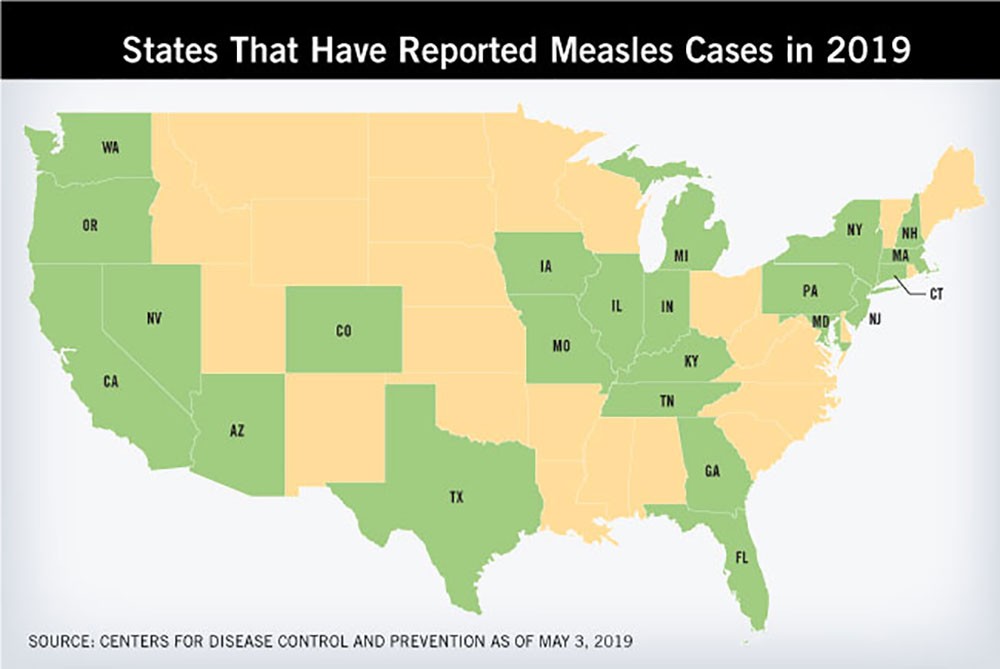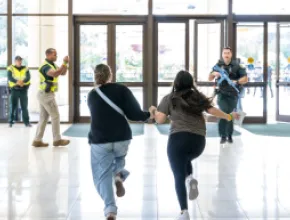A measles outbreak in the U.S. that threatens to become a pandemic may carry major repercussions for the meetings and conventions industry.
Measles, which was declared eliminated by the CDC in 2000, has come back with a vengeance.
764 individual cases of measles have been confirmed in 23 U.S. states as of May 3, 2019, which the Centers for Disease Control and Prevention (CDC) reported is the greatest number of cases reported in the U.S. since 1994. Our map above shows the states with current reported measles case in the U.S. as of May 3, 2019.
In April 2019, we reported on the measles outbreak in Los Angeles County, including a potential exposure at the Los Angeles International Airport (LAX). LAX, along with all airports, is highly trafficked by those in the meetings and events industry.
[Related Content: Risk Management Best Practices for Meeting Planners]
How can planners address this outbreak and the risk of it happening more frequently and at other public places, like hotels or convention centers where meetings are held?
In that same article about the measles outbreak in L.A. County we shared tips on how to protect yourself and attendees from measles as well as other airborne diseases. With the threat now growing further, we turned to two industry experts for their advice and more details on what planners should do to further ensure the safety and well-being of attendees.
How to Protect Meeting Attendees From Measles

Brenda Rivers, founder and CEO of Andavo Meetings:
Measles is a growing risk as the number of cases are spanning numerous states and locations that are top destinations for meeting planners. Obviously, current and near-future meetings were planned months before the measles outbreak.
Now that measles is a foreseeable threat, planners can take these steps to prepare for measles exposure during their events.
- Determine if your event is in a location in or near recent measles cases. Continue to monitor your event location in the CDC, County Department of Public Health and local medical services up to the start date of the event.
- Engage your hotel, convention center and venues in a pre-event safety discussion that includes understanding their emergency procedures to handle a pandemic during an event. Find out any statistics regarding past airborne illnesses. Investigate the current state of preparation for measles with all your event first responders.
- Include event hygiene best practices in your agreements for hotel, catering and meeting room set-up. Meetings Today shared some tips on these practices.
- Advise attendees of the meeting organizer’s awareness of the potential for measles exposure based on current public health reports and the commitment to a healthy and hygienic event environment. This could be communicated via the event website, attendee email blasts, event applications, etc.
- Publish “Stay Healthy-Know Before You Go” tips in your event registration process that include “How to prevent the spread of measles,” and “What to do to avoid exposure to measles while traveling to and from your event.” Provide ongoing health tips in the event mobile app during the event. Develop and implement a risk management policy to protect the health of all attendees that includes advice to attendees who have not been vaccinated or who might be feeling sick when they arrive at the event.
- Have pre-event discussions on how you will assist an attendee who appears to be sick during the event. Do not leave this to a last-minute reaction by the planning team. It is more likely that you will not have a full measles epidemic during the event, but you will have an attendee who exhibits symptoms of a cold or flu, which will not be easily identified as measles until it is too late to separate the attendee from the group.
- Document all the above in your risk management playbook.
Remember that the meeting planner is not the guarantor of the safety of attendees, but your duty of care does mean you should investigate the risk and control the controllables, including providing preventive measures.
Tyra W. Hilliard, meetings industry speaker, attorney and professor:

What is most important for planners is to make sure they are getting their information from reliable sources.
For any kind of health or disease-related concern, the Centers for Disease Control (CDC) and World Health Organization (WHO) are the best sources of information.
If the state to which a meeting planner is taking a group is listed on the CDC’s page on current measles cases and outbreaks, the planner should contact that state's Department of Public Health for more detailed information about the risk in specific locations. Because measles is a "mobile" disease, cases anywhere in the state should indicate a risk anywhere in the state.
The CDC has health warnings for "the Traveler." The Measles information for travelers from the CDC includes a short video (embedded below) that could be posted on a conference site.
I would certainly advise that both planners and meeting attendees be advised to monitor these as well as check the World Health Organization’s information on health, diseases and vaccines for international travel. It appears their list of diseases is currently being updated.
[Read This Next: How to Avoid the Flu at Meetings and Events]







